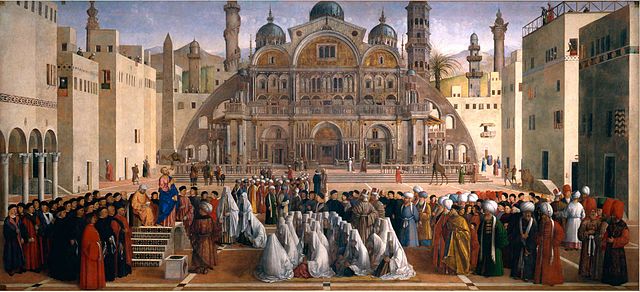
* (Gentile Bellini, St. Mark Preaching in Alexandria(1504-7) With his posthumous ubiquity paled comparing to that of his baby brother, Giovanni, Gentile Bellini nonetheless managed to achieve an optical accuracy through his relatively less prolific oeuvre. Providing a monumental painting like St. Mark Preaching in Alexandria, the canvas has ample capacity to enclose an almost panoramic view of the religious ceremony- people uniformly thronging around here and there, blocked only by the encompassing buildings. Every subtle detail is attended to with great finesse. Just by looking at those adorned pillars and the ruffles on the monks’ robes one might be illusioned of seeing some work of photography. A compelling sense of solemnity surges from the painting and swirls around the pillars, the rooftops, until it finally reaches the zenith.)
I toss and turn yet the somnolence is ever one-step behind the descending darkness. I feel the pulsating heart of weariness, my eyes glance involuntarily at the clock which proceeds so slowly. This will be a long night. I try every possible means to build a dream, or at least pave a pathway that leads to the final reverie. Building dreams can be laborious, and frustrating also if the kingdom of dream you built lasted no sooner than the sun, who untimely awoke and exerted its formidable power, onto every brick that eventually melt.
Thus I begin to build my dream, employing every brick that is likely to create a dream that will tide me over this night of malice. Someone once told me building dream is like forming a well-fabricated story. Such story is permitted to be the most chimerical, with every disparate detail amalgamates to a hodgepodge of wonder. Every piece of one’s memory is by no means an undervalued block to be overlooked. I dredge up mine regardless of the sadness or painfulness of some. A dream is a dream undistinguished of its good or evil.
Bad memories, if included, are the unfitted piece that ever tricked out from a well-structured dream, as if only a single window is crowned above with a single piece of cornice. However, if such bad memories are served as a base of the architecture of dream, the magnificent building you create will be something far different from a normal, dull one. This is the manifestation of genius in its unconsciousness, and I defy anyone who brands it the embryo of a nightmare.
So every incident that has left bitter aftertaste within me I gather them altogether as the base. Every betrayal, trauma, failure, deceit, fraudulence, stupidity, inanity, and behind them, the initiator, the foe- once and for all I recruit them into the dream I build diligently, as intimate as the act can be, and treat them as my confidantes, my lovers. To dream those bad memories off I naively supposing the termination of them.
Nevertheless, I am wrong. I wake up unknowing the lapse of time, pajamas drenched in sweat. The dream sleeps by now but as soon as it ends I start pining for it. Yes, I pine for the fantastical building I have built, forgetting what I don for its middle bulk and the top, knowing only the base I stuff with all the past malice. An unaccountable longing and passion yet surge, and heave my whole body up. I long to seize those bad memories and foes close to my heart, to squeeze them and fondle them, treat them as a once estranged lover of mine I never want to lose again. I can even slave away for them, regardless of how much hatred and indignation I had accumulated. In light of the longing I plot and sketch furtively a building of dream for tonight, and those that are served as the foundation should be piled higher.
Comments
Post a Comment